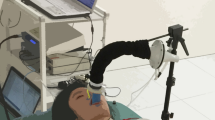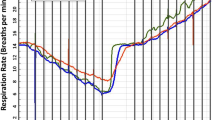Abstract
Objective.A new photoplethysmographic (PPG) device for respiratoryand heart rate monitoring has been evaluated in the neonatal care units at theUniversity Children's Hospital of Uppsala, Sweden. The purpose of thisstudy was to compare this new device with more established techniques, i.e.,transthoracic impedance plethysmography (TTI) for monitoring of respiratoryrate and ECG for heart rate monitoring. Methods.Data were acquiredcontinuously for 8-hours in each of 6 neonates. The signals were analysed forperiods of 30 seconds, in which the heart and respiratory signals from the PPGdevice were compared with the ECG and the impedance plethysmogram. Results.The ECG recordings were of high quality in 77% of the analysed periods.In these periods, excluding periods (6%) disturbed by offset-adjustement ofthe PPG signal, the PPG heart signal included 1.1% (±0.7% SD) falsenegative beats and 0.9% (±0.6%) false positive beats. In periods withan impedance signal of high quality (29% of total time), the part of the PPGsignal synchronous with respiration included 2.7% (±1.1%) falsenegative breaths and 1.5% (±0.4%) false positive breaths. Here, 2% ofthe periods were discarded because of offset-adjustment. From the periods oflow signal quality, two other conclusions were drawn: 1) The impedance signalcontains more power in the respiratory range than the corresponding PPGrespiratory signal. 2) The breaths are easier to identify in the PPGrespiratory signal than in the impedance signal (subjective measure).Conclusions.Electrode and motion artefacts seem to disturb the ECGsignals and, particularly, the impedance signals. During periods of highquality ECG and impedance signals, the new optical device produces signals ofequal quality to these traditional methods, and is in some cases even better.The new device is non-invasive and has a small optical probe. These factorsindicate further advantages of the photoplethysmographic method.
Similar content being viewed by others
REFERENCES
Allison RD, Homes EL, Nyboer J. Volumetric dynamics of respiration as measured by electrical impedance plethysmography. J Appl Physiol 1964; 19: 166–173
Rolfe P. Magnetometer respiration monitor for use with premature babies. Biomed Eng 1971; 6: 402–404
Cohn MA, Rao ASV, Broudy M, Birch S, Watson H, Atkins N, Davis B, Scott FD, Sackner MA. The respiratory inductive plethysmograph: A non-invasive monitor of respiration. Bull Eur Physiopathol Respir 1982; 18: 643–658
Lewin JE. An apnea alarm mattress. Lancet 1969; 27th Sept: 667–668
Tremper KK, Barker SJ. Pulse oximetry. Anesthesiology 1989; 70: 98–108
Huch R, Huch A, Lübbers DN. Trancutaneous measurement of blood pO2 (tcpO2) method and clinical application in perinatal medicine. J PerinatMed 1973; 1: 183–191
Werthammer J, Krasner J, DiBenedetto J. Stark AR. Apnea monitoring by acoustic detection of air£ow. Pediatrics 1983; 71: 53–55
Sullivan WJ, Peters GM, Enright PL. Pneumotachographs: Theory and clinical application. Resp Care 1984; 29: 736–749
Henneberg S, Hök B, Wiklund L. Remote auscultatory patient monitoring during magnetic resonance imaging. J Clin Monit 1992; 8: 37–43
Challoner AVJ. Photoelectric plethysmography for estimating cutaneous blood £ow. In: Rolfe P, ed. Noninvasive physiological measurement. London: Academic Press, 1979
Kamal AA, Harness JB, Irving G, Mearns AJ. Skin photoplethysmography a review. Comp Methods Prog Biomed 1989; 28: 257–269
Lindberg L-G, Ugnell H, Öberg PÅ. Monitoring of respiratory and heart rates using a fibre-optic sensor. Med Biol Eng Comp 1992; 30: 533–537
Olsson E, Ugnell H, Öberg PÅ, Sedin G. Photoplethysmography for simultaneous recording of heart and respiratory rates in newborn infants. Med Biol Eng Comp 1996; 34 (Suppl 1, Part 1): 277
Baird TM, Goydos JM, Neuman MR. Optimal electrode location for monitoring the ECG and breathing in neonates. Ped Pulm 1992; 12: 247–250
Ugnell H. Photoplethysmographic heart and respiratory rate monitoring using photoplethysmography. Thesis no. 386, Department of Biomedical Engineering, Linköping University, Sweden
Martin H, Norman M. Skin microcirculation before and after local warming in infants delivered vaginally or by caesarean section. Acta Ped 1997; 86: 261–267
Kamath MV, Fallen EL. Power spectral analysis of heart rate variability: A noninvasive signature of cardiac autonomic function. Crit Rew Biomed Eng 1996; 21: 245–311
De Meersman RE, Zion AS, Teitelbaum S, Weir JP, Lieberman J, Downey J. Deriving respiration from pulse wave: a new signal-processing technique. Am J Physiol 1996; 270 (5pt2): H1672-H1675
Brecher GA.Venous return. NewYork: Grune & Stratton, 1956
Tur E, Tur M, Maibach HI, Guy RH. Basal perfusion of the cutaneous microcirculation: measurements as a function of anatomic position. J Inv Dermat 1983; 81: 442–446
Mendelson Y, Solomita MV. The feasibility of spectrophotometric measurements of arterial oxygen saturation from the fetal scalp utilizing noninvasive skin-re£ectance pulse oximetry. Biomed InstrTechnol 1992; 26: 215–224
Barrington KJ, Finer NN, Ryan CA. Evaluation of pulse oximetry as a continuous monitoring technique in the neonatal care unit. Crit CareMed 1998; 16: 1147–1153
Salerud EG, Tenland T, Nilsson GE, Öberg PÅ. Rhythmical variations in human skin blood £ow. Int J Microcirc Clin Exp 1983; 2: 91–102
Wilks PAD, English MJ. Accurate segmentation of respiration waveforms from infants enabling identification and classification of irregular breathing patterns. Med Eng Phys 1994; 16: 19–23
Wilson AK, Franks CI, Freeston IL. Algorithms for detection of breaths from respiratory waveform recordings of infants. Med Biol Eng Comp 1982; 20: 286–292
Martin RJ, Fanaro¡ AA. Neonatal apnea, bradycardia, or desaturation: Does it matter? J Pediatr 1998; 132: 758–759
Daily WJR, Klaus M, Meyer HBP. Apnea in premature infants: monitoring, incidence, heart rate changes, and an e¡ect of environmental temperature. Pediatrics 1969; 43: 510–518
Kimura T, Kambe M, Utumi T, Yamakido M. Volume pulse wave and respiratory diseases. Jap J Clin Pat 1994; 42: 413–417
Author information
Authors and Affiliations
Rights and permissions
About this article
Cite this article
Johansson, A., Öberg, P.Å. & Sedin, G. Monitoring of Heart and Respiratory Rates in Newborn Infants Using a New Photoplethysmographic Technique. J Clin Monit Comput 15, 461–467 (1999). https://doi.org/10.1023/A:1009912831366
Issue Date:
DOI: https://doi.org/10.1023/A:1009912831366




